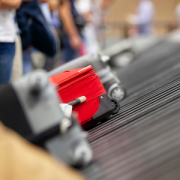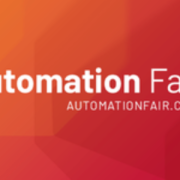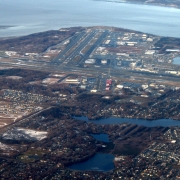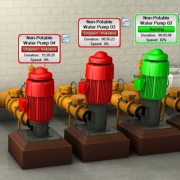RFID: Benefits, Barriers and the Future
The Current State of RFID in Material Handling
Do Radio Frequency Identification (RFID) systems make sense for your operation? In many material-handling operations, RFID has proven to have advantages over other tracking technologies. It is known for having a higher accuracy in read rate percentages, fewer errors and more durable tags. An RFID system has the potential to pay for itself over time due to the potential increases in efficiency and decreases in errors.
 We interviewed Mina Hanna, Senior Sales Executive at RFRain, an RFID solutions company, to check in on the current and future state of RFID and to discuss the benefits and barriers of implementation of this technology.
We interviewed Mina Hanna, Senior Sales Executive at RFRain, an RFID solutions company, to check in on the current and future state of RFID and to discuss the benefits and barriers of implementation of this technology.
ControlTouch: What are the benefits of RFID over other tracking technologies?
Hanna: There are tremendous advantages and benefits that real-time asset tracking can provide businesses to compete in today’s environment. RFID maintains a 99% accuracy independent of item orientation, position, or speed. RFID uses radio technology to communicate with embedded, encrypted chips in smart labels attached to everything from packages to passenger luggage. Through this system, individual items are tracked, located, and cataloged with extreme precision, regardless of the size of the operation.
With RFID, the reliability to read a tag is much greater than a barcode. A barcode is just writing on a piece of paper. It is a 1-to-1 read and must be in a direct line of sight. Barcodes can be blocked, and there is a higher rate of misreads, whereas RFID can read multiple tags at once, and because the tag is a chip, it is much more durable and has a longer lifespan.
In Aviation, they do not use barcode alone for tracking bags. They use barcode and either image recognition, OCR or other multiple technologies to stack on top of each other to do what RFID can do stand-alone. For example, if a barcode can get a 95% read rate, then they can add OCR to increase another 3% or 4% to get closer to the 99% rate of RFID. In terms of cost, if it is a green site or if an airport is building up a new zone, it has much less to build out with RFID in mind than building out with multiple technologies.
ControlTouch: What are the barriers to implementing RFID?
Hanna: Historically, it can be complex and expensive to implement an RFID solution.
The customer’s infrastructure is not set up for RFID, and they probably have a barcode system, OCR, or another tracking technology. They already have their system set up on their servers, including a full inventory tracking or baggage tracking, so there are multiple technologies on their servers. The disadvantage is they need to get a reader and integrate it into their systems by creating new infrastructure, and start with low-level protocols and rewrite software stacks to implement it fully.
The current way RFID is implemented is hindering its growth. Existing RFID solutions require the customer to purchase an RFID reader from a vendor, a gateway with middleware from another vendor, and software from another. Also, current RFID solutions require customers to hire a consultant to build the system. This can make the RFID solution complicated and expensive to implement.
However, the introduction of newer technologies and smart readers are helping to lessen this impact and making it easier than ever to implement an RFID solution. In some cases, it can be 10X less to implement a smart RFID solution.
ControlTouch: What is the current condition of the RFID market, and what is happening within the industries of Material Handling in airports and retail distribution centers?
Hanna: The current condition, whether it is for aviation or retail, is the same. On their process lines or conveyor belts, you have a reader that is essentially just a piece of hardware that acts as a transponder. It picks up the tag, and then it reports it back to the PLC. The reader doesn’t have any software that lives on it directly. Neither business logic nor computing happens on the reader. It reads the tag then sends the information to the PLC, and then PLC will tell the machine or conveyor belt what to do based on that reading. Either the software lives on an onsite server or in the cloud.
The end units the customer picks must be purchased based on their specific application and implementation. A reader could work very well for baggage handling, but the same conveyor belt system would not operate well for retail because you could be reading a few tags at a time compared to just one. The majority of readers have an issue where they do not read all the time but, sleep in between reads. Readers read every two to three seconds. Therefore, it will miss some tags that go by. This is why tag read distance and the reader read distance are both very important. If the tag passes while the reader is sleeping, the only way you are going to be able to read that tag is if it is within the read distance after the fact when it starts reading. Readers on the market cannot do things like doorway implementation or beyond the conveyor belt. That is why they have to do an overhead implementation or zone reading. The current market is application-specific and cumbersome. There are so many different pieces working and the intelligence does not reside in the end unit.
The trend is to build smart factories, smart airports or the airports of the future, or smart retail or get-ready-for-retail 4.0. The issue is the technology of the end units has not improved enough in the last 20 years. Standard end units are unintelligent or “dumb” units. They are just a piece of hardware. If we are building smart cities, smart factories, and smart airports, then our end units need to be smart – just like items you have at home, such as Alexa, Nest or Ring. Those are true intelligent devices because the software resides right on those end units where the computing happens and is connected to a network or server to send the information for data collection and management.
Today, with most RFID readers, the end units are not smart, and the computing is happening somewhere else.
ControlTouch: Why is it bad or limiting that the computing is happening somewhere else instead of on the end unit in RFID?
Hanna: Think about your cell phone, for instance, the iPhone. A lot of computing happens locally on the phone. You do not have to connect to Apple’s iCloud to do and save things on your phone. An excellent example of this issue is when Apple first introduced Siri. When Siri first came out, it lived in the iCloud and on their servers. Minimal computing was on the phone, but for most computing, more in-depth commands and updates; you had to be connected to the iCloud. This created many issues because when you are depending on the computing happening somewhere else, it takes time. You are collecting the data, instead of doing something with the data right there, you are pushing the data, and you are dependent on network connectivity on both ends. The computing happens over there and then is sent back, which makes it a slower process. Apple decided they needed more computing power on the iPhones, so now, the Siri software lives on the phone. You no longer need to be connected to the cloud, which improved the user experience with Siri.
Readers read every three to five, or two to three seconds because the server or the gateway or the PLC is telling them to read, and it just takes more time, which is why smart readers are important. The smart readers RFRain has developed uses the same concept Apple developed to improve Siri and the software lives locally on the unit.
On top of this, many readers in the market communicate in a protocol called LLRP – the Latin of computer language. You must go to a middleware company to translate the language into a CC++ or PHP and then go to a software company to decrypt the data. Within the last couple of years, there is a movement away from LLRP, but the major players in the game are still using it.
ControlTouch: Where is the RFID industry going?
Hanna: To help create and be a part of Smart Factories or Smart Airports, the RFID reader needs to be smart. The reader needs the ability to be taken out of the box, plugged in and it starts reading tags. With everyone else, that is not the case. You need a reader and a gateway, then gateway tells the reader what to do; then you need to add middleware to the gateway to translate to the software that lives on a server or a cloud.
Our Plug-and-Play Smart Reader includes the reader, gateway, and software all in one device – which eliminates the need for piecemeal hardware making it easy to build scalable RFID solutions. The Smart Reader can read every 300th of a second compared to two or three seconds because the software lives locally and it does not take as much time for data transfer. Implementing a Smart Reader takes about 20 minutes, where a typical RFID implementation can take weeks or months.
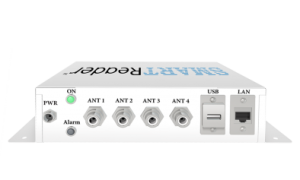 ControlTouch: How has COVID affected the RFID industry, and what’s next?
ControlTouch: How has COVID affected the RFID industry, and what’s next?
Hanna: The pandemic has inspired innovation. Customers are looking for ways to have contact-less, seamless interaction and contact-less, seamless inventory management. These new requirements have helped expedite the adoption of RFID technologies in the market. No matter how long we have to deal with COVID, RFID helps businesses improve and streamline their processes.
In the airline industry, RFID Smart Readers with baggage tracking is the crème de la crème in terms of tracking bags. It is better than a barcode, OCR and everything else. We can keep a very accurate count of where the baggage is at all times. However, this works great in retail as well. In terms of inventory management and retailers, we have all seen the change in how people purchase and the growth of eCommerce. They are going to continue to focus on the supply chain and how to use RFID to help them handle the change in their businesses. Inventory management in Health Care is huge with the amount of use of PPE. When there is a health scare or a pandemic, keeping track of inventory is the last thing on everyone’s mind. How are we going to do better? And the answer is UHF RFID and Smart Cabinets.
To learn more about RFRain visit their website or check out this article on their new UHF RFID Smart Readers in the RFID Journal.



